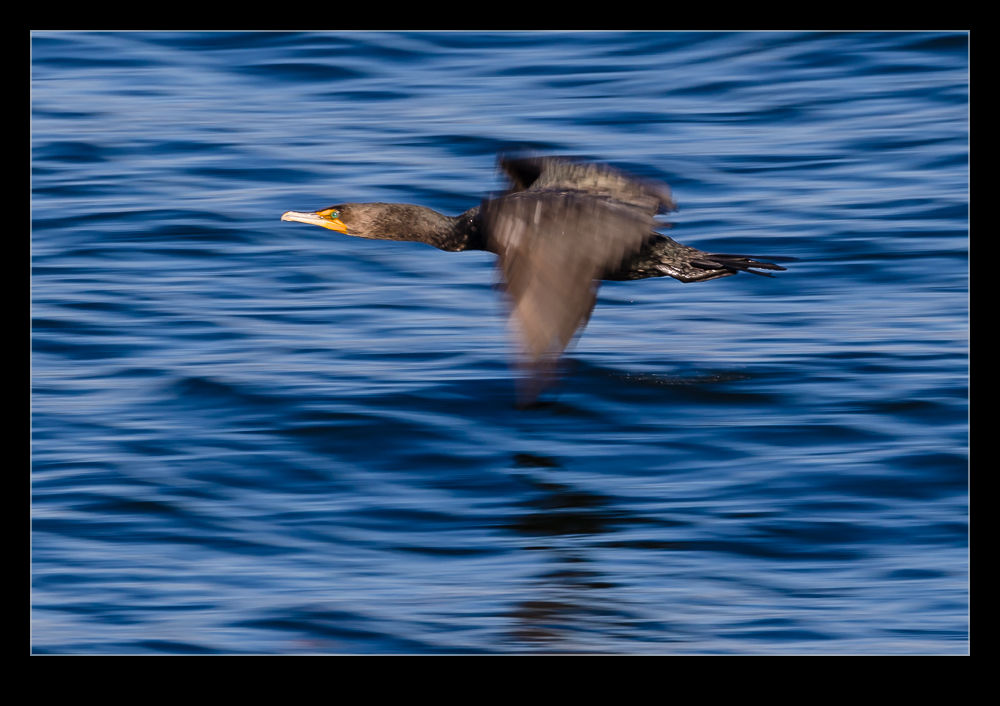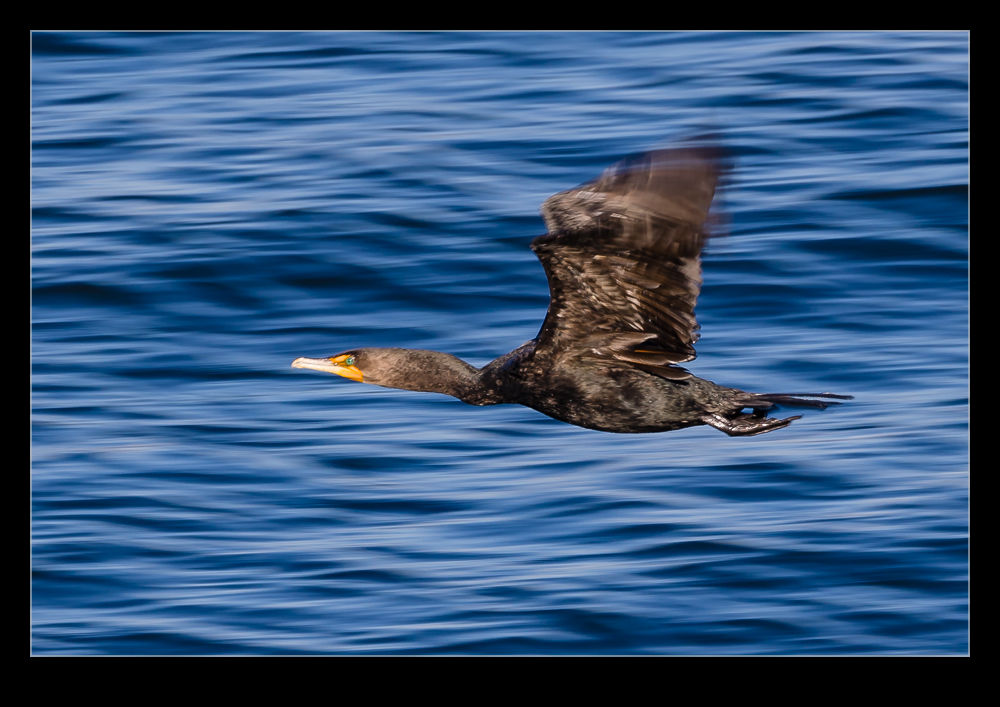 An impromptu shot of a cormorant is a good thing as far as I am concerned. Normally when I photograph birds, I am shooting wide open at as high a shutter speed as possible. However, this time I was set up for shooting at a lower shutter speed when the cormorant came by. Consequently, the success rate was down a bit. I did still get some shots though and the motion blur gives more of a feel of speed, even if it is just the water blurring out.
An impromptu shot of a cormorant is a good thing as far as I am concerned. Normally when I photograph birds, I am shooting wide open at as high a shutter speed as possible. However, this time I was set up for shooting at a lower shutter speed when the cormorant came by. Consequently, the success rate was down a bit. I did still get some shots though and the motion blur gives more of a feel of speed, even if it is just the water blurring out.
Tag Archives: technique
Making Use of the Camera’s Features
One of the things that I was glad to get when I last changed camera bodies was the ability to have exposure compensation while shooting in manual mode. You might wonder why this is a useful thing to have but I was shooting a couple of time recently when it was useful. Sadly, the first time I didn’t think to use it. The second I did though. This is the result of shooting in dark conditions when the light levels are changing quite a bit.
The problem in the first case was that I was shooting in aperture priority mode. The light was low, so I went to auto ISO to allow it to adjust. The camera looks to get a shutter speed that is related to the focal length of the lens you are using. I was shooting a landing aircraft and, when I was out at the full length of the zoom, it kept shutter reasonably high. However, as the plane got closer and I zoomed out, the camera dropped the shutter speed down which meant the panning resulted in a lower keeper rate. I should have foreseen this and I was annoyed with myself.
The next time, I thought through the issue a bit better. A gray sky meant that I needed to have some positive exposure compensation. I went to manual mode, set the shutter speed and aperture that I wanted but included the exposure compensation. Then I set auto ISO. Now I had the ISO adjusting to get the combination I wanted while including exposure comp. On my old bodies, this was not possible. The result was the exposure I wanted with ISO adjusting throughout the sequence. When conditions are not great and changing quickly, this is an approach I can highly recommend.
The Lucky Shot I Got By Accident
When totality occurred during the eclipse, I was literally and figuratively in the dark. I had practiced shots of the sun prior to the day to get the exposure right and, while the eclipse covered up the sun, the remaining section was unaffected so the exposures were right. Besides, I bracketed each shot because, we, why not? At totality, I removed the solar filter and switched to program mode because I didn’t want to have to work anything other than the shutter. I still bracketed the shots.
I got shots that I really liked but, I didn’t get anything that showed any detail around the edge of the eclipse. Everything was bright. Even with wide bracketing, the shots were quite blown out. I was a little disappointed by this but it was a minor thing. Seeing the eclipse had proved to be far more satisfying than any shot I got. However, it turns out an error of mine had a lucky side effect.
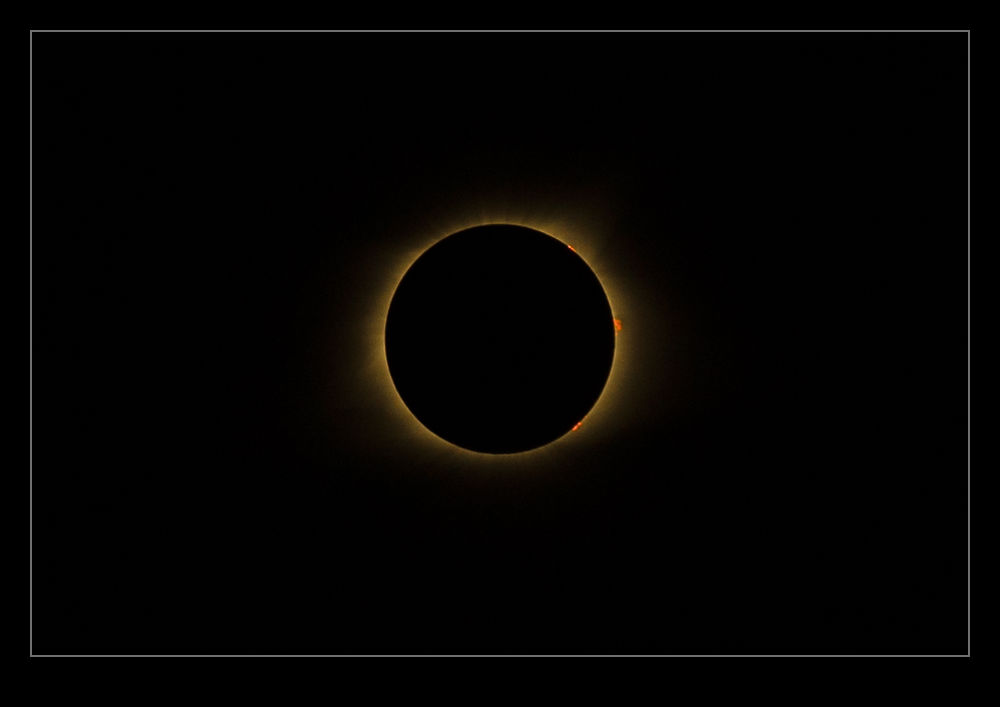 I had been shooting a time lapse sequence on the other camera. When I removed the solar filter (eventually) during totality, I didn’t change the exposure. Consequently, the shots were a lot more underexposed than the shots on the other camera. While the subject was a lot smaller in the frame because of the framing for the time lapse progression, I still had some detail of the eclipse and I realized some solar flares were visible on the side of the eclipse. I hadn’t planned this – it just happened by luck and I am happy to take all the luck I can get. As they say, “Better to be lucky than good!”
I had been shooting a time lapse sequence on the other camera. When I removed the solar filter (eventually) during totality, I didn’t change the exposure. Consequently, the shots were a lot more underexposed than the shots on the other camera. While the subject was a lot smaller in the frame because of the framing for the time lapse progression, I still had some detail of the eclipse and I realized some solar flares were visible on the side of the eclipse. I hadn’t planned this – it just happened by luck and I am happy to take all the luck I can get. As they say, “Better to be lucky than good!”
Can You Find Yourself in North Vancouver?
Standing on the shore in Vancouver on a sunny Sunday afternoon provided a great view of North Vancouver. Plenty of boats were making their way across the bay including some large ones which proved a little problematic for this task. I figured I could use the long lens, shoot a large sequence and create a panorama when I got home. It turned out that Photoshop and Lightroom both struggled compiling this panorama so I ended up positioning everything manually. However, it all worked out pretty well. Here is the result. Feel free to navigate around to see what you can find.
Another Go at Stitching iPhone Raw Shots
 As I posted a while ago, I have been experimenting with stitching shots from my phone. Since I am shooting in raw on the phone, I have some latitude to play with the shots in post that wasn’t there before. This time, though, I thought about it a bit more and put the camera into manual mode to fix the exposure. This should make the stitching and blending easier than when it changed between shots (although, to give the Lightroom team credit, it did a pretty good job anyway). I allowed plenty of overlap and the merge seemed to go pretty well. Since it outputs a dng file, you still have the chance to edit more aggressively than would be possible with a jpeg. Meanwhile, you get a higher resolution shot than with the internal pano mode. This may be my go to method from now on.
As I posted a while ago, I have been experimenting with stitching shots from my phone. Since I am shooting in raw on the phone, I have some latitude to play with the shots in post that wasn’t there before. This time, though, I thought about it a bit more and put the camera into manual mode to fix the exposure. This should make the stitching and blending easier than when it changed between shots (although, to give the Lightroom team credit, it did a pretty good job anyway). I allowed plenty of overlap and the merge seemed to go pretty well. Since it outputs a dng file, you still have the chance to edit more aggressively than would be possible with a jpeg. Meanwhile, you get a higher resolution shot than with the internal pano mode. This may be my go to method from now on.
Sacramento Roundhouse
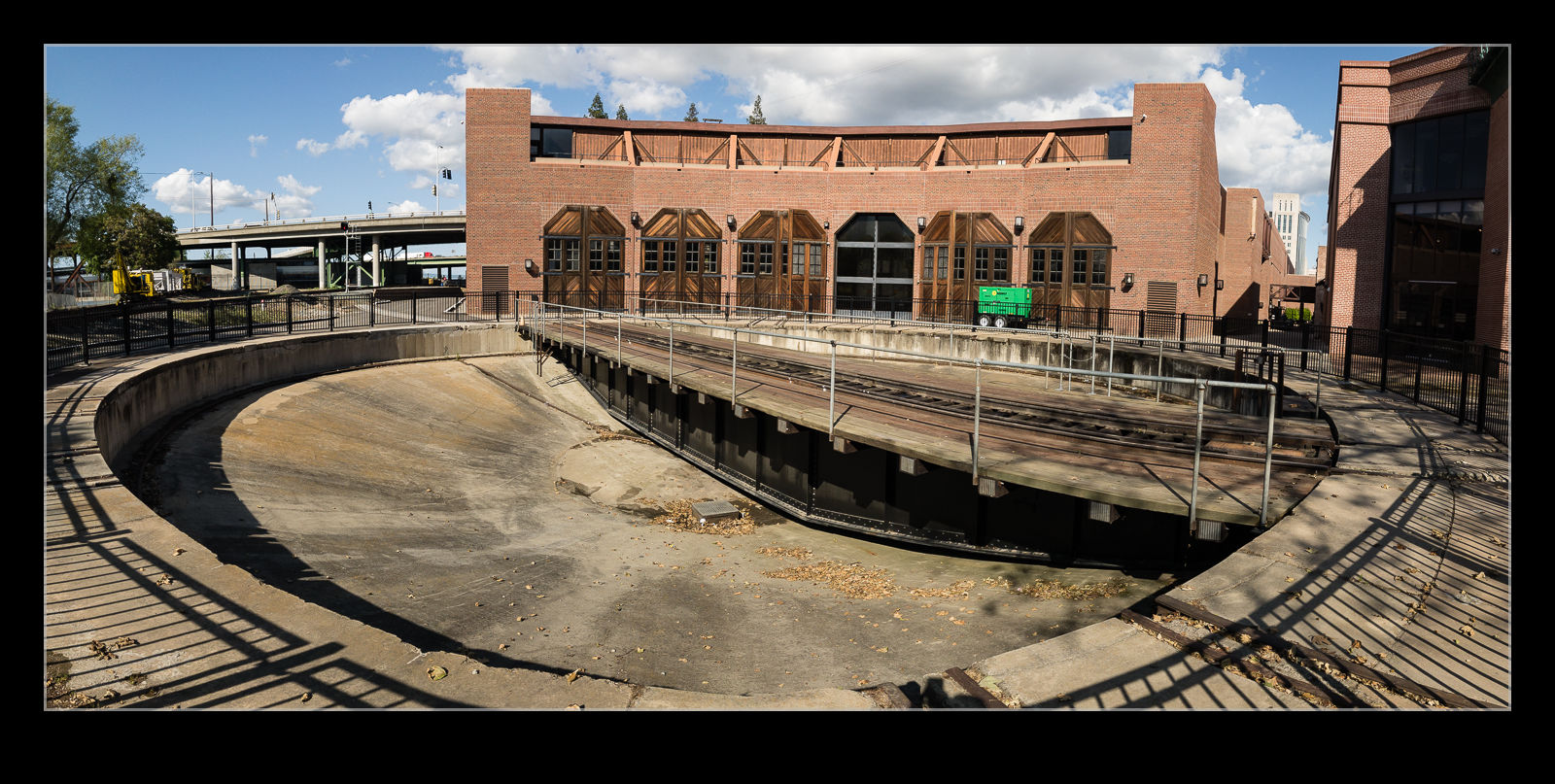 One end of the railroad museum in Sacramento is a roundhouse. It is accessible still from the line outside and I was there for a modern locomotive that was being unveiled. Access comes via a turntable which sits right next to the path along the river. I figured I would put together a panorama of the scene. However, I only had my phone (albeit able to shoot raw). I had never tried shooting a pano sequence with it before having only used its internal pano function.
One end of the railroad museum in Sacramento is a roundhouse. It is accessible still from the line outside and I was there for a modern locomotive that was being unveiled. Access comes via a turntable which sits right next to the path along the river. I figured I would put together a panorama of the scene. However, I only had my phone (albeit able to shoot raw). I had never tried shooting a pano sequence with it before having only used its internal pano function.
I wasn’t controlling the exposure (although there is a manual function in the app I use) but I had noticed that the Lightroom pano function seemed quite adept at dealing with small exposure variation. I took the sequence and there was not a big difference across them. When I got home, I added them to Lightroom and had a go at the stitching function. It worked better than I had expected. Some small distortions were there but it actually was rather good. I had not been happy about the reduced size of the pano function of the phone so this has provided a better option to use in the future.
Shooting RAW on the Phone
The update to iOS 10 brought with it the possibility to shoot in RAW on the iPhone. For some reason Apple didn’t bother to incorporate this feature in the base phone app but they did make it available to other camera app developers. Camera+ is one that I use a bit so I figured I would start shooting in RAW via that. Obviously RAW means larger files but, since I download my files to the desktop frequently and tend to clear out the phone, this wasn’t a concern.
First thing I found out was that other apps could see the shots. I had taken a few shots and wanted to upload to Facebook and it turned out there wasn’t a problem doing so. However, the main benefit was anticipated to post processing back on the desktop. With the SLR shots (is there any point to saying DSLR these days?), it is possible to recover a lot from the highlights and shadows. Would the same be possible with the phone? Sort of. You can get a bit more in these areas than would be the case with the JPEG when things are quickly lost. However, the sensor data is still not anywhere close to being as adaptable as it is for an SLR. You get more flexibility to pull the sky back but it is still pretty limited.
Is it worth using? Definitely. While it might not be the post processing experience you will be used to with SLR files, it is certainly better than the JPEGs provide. The increase in file size is hardly an issue these days so I will using it from now on. The camera app doesn’t have the pan and time lapse stuff so easily to hand so the phone’s base app will still get used but, aside from that, it will be my choice. My main gripe now is that they have a random file naming protocol that is a little difficult to get used to. Small problems, eh?
Sound for the Videos
While I have experimented with video a fair bit over time, one thing I haven’t done is put together a video with a presenter in it. My mum was recently staying and she had an idea for something she wanted to do that involved her doing a presentation on video that could be shared at a later date. My own experience and some information I had seen online made me think that the key to getting a good result was not going to be the video but was instead the sound. The microphone on the camera is of okay quality but it picks up the sound of everything around it. The voice is isolated and any video online that does not take a careful approach to audio is very obvious and sounds decidedly amateurish.
The ideal solution would be to have lav mikes, the small mike you see attached to the clothing of TV presenters. These are actually pretty accessible and cheap but I didn’t have the time to sort something out. However, a surprisingly good alternative was readily to hand. I have an app on my phone for sound recording which I use when interviewing people for articles. Instead of using the plugin microphone, I used the headphone/microphone cable. By running it inside the clothing and just leaving the microphone up near my mum’s throat, we were able to make a very good sound recording. The closeness of the mike to her mouth meant the sound was very localized and clear so the background noise was lost. The room we used did not have bad echoes either so the audio ended up being pretty clear.
Then it was just a case of having a conspicuous clap on the audio track and the video file to allow me to synch the sound and audio together and we were off to the races. I shot everything with two cameras – one head on and one from the side – with the idea of cutting between them. However, when I did the first edit, the side camera didn’t seem to fit with the style of presenting to camera. I imagine it works better for an interview style piece. I reverted to the head on shot with some images cut in periodically to illustrate the piece. Overall, it worked pretty well. We did a number of takes and mum got progressively more relaxed in each one. I had thought I might cut the best bits together but the final take was really good so I didn’t need to do so. I hope her audience likes the result.
Trying to Remove the Traffic on the Bridge
The suspension bridge at Lions Gate in Stanley Park, Vancouver is a magnet for photographers. I was only passing through but, as we watched the traffic moving across the bridge, I was thinking about how to get a shot that didn’t have cars on it. The traffic was steady so there was not way I would get a clear moment. Indeed, while we were there, they changed the lights and reversed the center lane based on the traffic demand.
I didn’t have a tripod but I did decide to experiment with an alternative technique. This is best done using a tripod and a lot of exposures but I figured I would go with shots that were pretty closely aligned and about half a dozen shots. This didn’t work perfectly but it didn’t go too badly. When you get back to the computer, you open up Photoshop. Click on File and Statistics and a dialog opens up. Select all of the files and change the option at the top to Median and check Align Images. Then send it on its way.
 If the shots are good and there are enough, the algorithm will look at each shot and see the changing items – cars in this case – as the oddities. It will see what is consistent in each shot and get rid of the odd stuff. If you have it right, the cars will vanish. In this case, there were some overlaps and not enough shots but it still did a reasonable job.
If the shots are good and there are enough, the algorithm will look at each shot and see the changing items – cars in this case – as the oddities. It will see what is consistent in each shot and get rid of the odd stuff. If you have it right, the cars will vanish. In this case, there were some overlaps and not enough shots but it still did a reasonable job.
Polarizer Comparison
When I changed bodies, I had to update some of my accessories too. My old filter system was fine on a cropped body but with full frame, the filter holder encroached on the corners for the wide angle lenses. I took the opportunity to change my polarizer set up. I used to use a polarizer on my Cokin holder. This was a bit inconvenient when I was using lens hoods. Instead, I decided to get a screw in polarizer. Since most of my lenses have the same filter size, this gives me more flexibility.
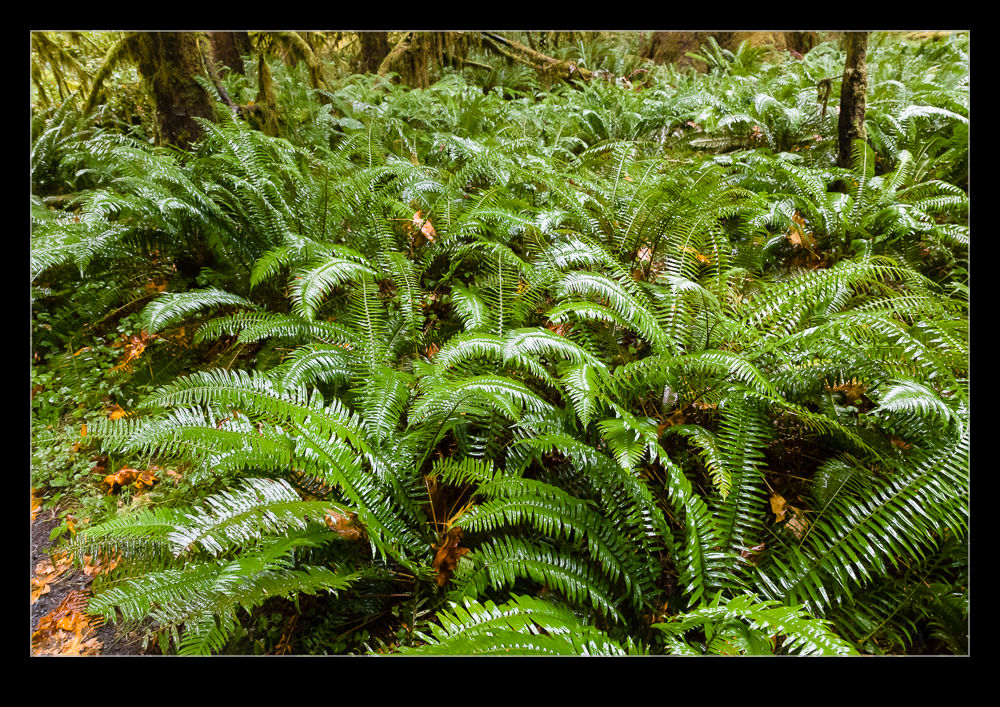
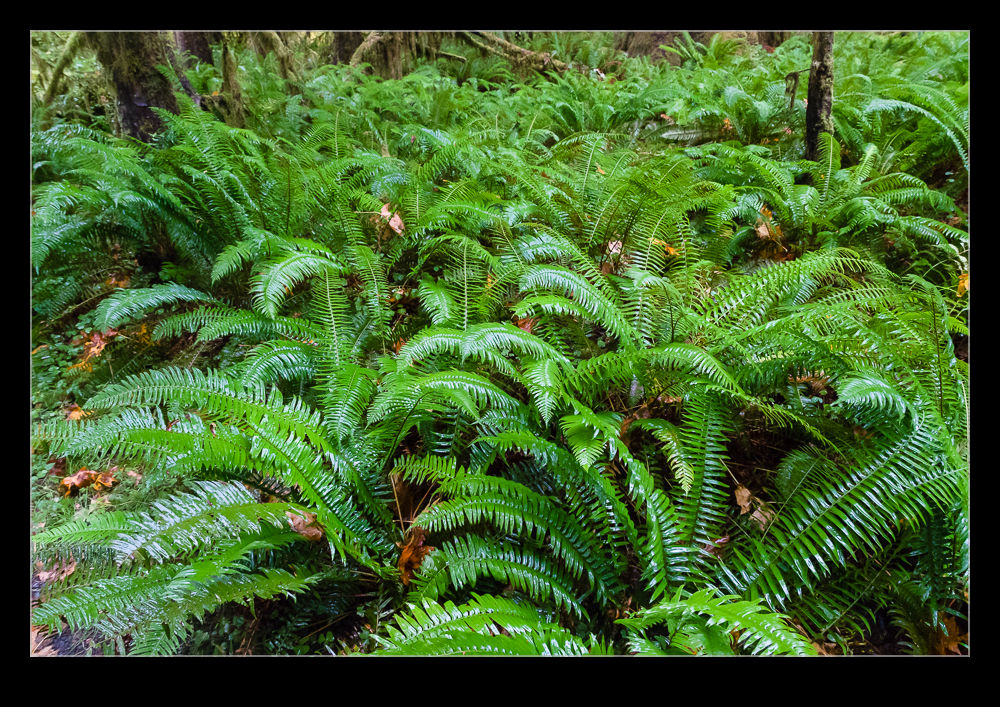 I took the polarizer with me on vacation. One place where I made good use of it was in the rain forest. While it was pretty dark in the heavy forest cover, there was moisture everywhere and this meant a lot of reflections and glare. Consequently, I went with the polarizer most of the time. While I was there, though, I decided to do some experimentation by repeating some shots without the polarizer to see how much of a difference it made. You can see the with and without shots here and judge for yourself what a difference it makes.
I took the polarizer with me on vacation. One place where I made good use of it was in the rain forest. While it was pretty dark in the heavy forest cover, there was moisture everywhere and this meant a lot of reflections and glare. Consequently, I went with the polarizer most of the time. While I was there, though, I decided to do some experimentation by repeating some shots without the polarizer to see how much of a difference it made. You can see the with and without shots here and judge for yourself what a difference it makes.
